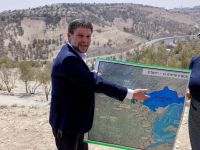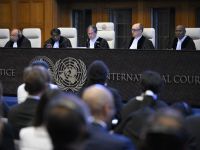By Nigel Thorpe
Chief of the English Copy Desk
Albawaba.com – Amman
Baghdad’s Arabic language newspaper, Alif Ba’s, reported “the completion of the new stages in the Al-Amiriyah Shelter Museum.”
The museum commemorates the bombing of (the) Al-Amiriyah complex by the “aggressor states” during a Desert Storm operation on 13 February which killed 421 Iraq civilians including 52 children and 261 women. In what is generally agreed by all parties to be one of the greatest tragedies of the Gulf War, allied bombers dropped “smart bombs” on what US commanders believed was a military installation used by the Iraq intelligence services. The Iraqis, however, have always insisted that the underground complex was an air raid shelter used solely by civilians.
In the aftermath of the Gulf War, the commanders of the allied forces have been widely criticized for using “smart bombs” on the basis of “dumb information.” In a CNN documentary on the Gulf War aired in mid January, however, members of the Iraq intelligence service were quoted as saying that their intelligence units had used rooms at the back of the underground Al-Amiriyah complex which had also been visited on at least one occasion by Saddam Hussein. American commanders interviewed in the same documentary said that, had they known the complex was used by civilians, they would never have authorized the bombing.
Whatever the true facts are behind the bombing, few could deny that the innocent victims of this tragic incident deserve a permanent memorial to both their memory, and to the horrors of war. Major General Qasim al-Shammari, director general of the Iraqi civil defense, acting on a directive from President Saddam Hussein, has set up a joint committee to collect photographs and document the personal details of those who died on that night fateful night in (the) Al-Amiriyah shelter. The major general confirmed that albums containing the photographs of those killed will be displayed in the shelter’s museum hall. The renovated complex will also feature a “monument to the martyrs” and a lounge which “will provide services for guests and delegations.” Visitors to the new museum will also be able to “see and hear audio-video effects depicting the night of the tragedy.” The museum’s entrance at ground level now features a pyramid of metal and glass that refracts bright beams of sunlight down into the former air raid shelter.
Meanwhile, the Kuwaiti authorities are finalizing their own memorial Gulf War celebrations. According to a statement by the Kuwaiti embassy on Monday quoted by CNN, Reuters, and other news agencies, former US President George Bush, father of the new President George W. Bush, will attend celebrations in Kuwait on February 26th marking the 10th Anniversary of the end of the Gulf War. The former president, who led the military campaign to drive Iraqi forces out of Kuwait, is the most prominent of 46 Americans who have accepted invitations to the celebrations. The official list issued by the Kuwaiti embassy also includes Gen. Norman Schwartzkopf, the commander of allied forces in the campaign, Gen. Anthony Zinni, until recently the commander of US forces in the Middle East, John Sununu, former President Bush’s chief of staff, and Edward Gnehm, former US ambassador to Kuwait.







